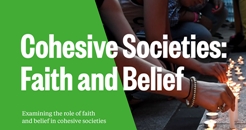 Faith groups and social cohesion
Faith groups and social cohesion
From a report by the British Academy and the Faith and Belief Forum
A report commissioned by the British Academy and the Faith & Belief Forum, has found that faith and non-religious belief groups’ positive contribution to social cohesion deserves greater recognition and should have more influence on cohesion policy in the United Kingdom.
‘Cohesive Societies: Faith and Belief’, by the thinktank Theos, charts social cohesion policy in the UK and examines the practical impact of the faith and belief sector on our communities and draws on practical case studies from across the UK.
The authors argue:
-
Social cohesion policy in the United Kingdom has developed in the context of four main factors: demographic shifts accompanying migration, the growth of the ‘non-religious’ affiliation, significant changes to the welfare state, and crises such as the ‘race riots’ in summer 2001.
-
Consequently, cohesion policy has been disproportionately dominated by concerns for national identity, security and loyalty, rather than by a desire to pursue social cohesion as an end in itself.
-
Faith is too often thought of as a concerning ‘other’ and a risk to social cohesion; it has also often been subtly racialised as the preserve of ethnic minorities in a broadly secular mainstream.
-
While faith and belief can be a source of division, many faith groups play a key role in social cohesion and their contributions need to be considered in the formation of cohesion policy.
Phil Champain, Director of the Faith & Belief Forum, said, “Faith and belief groups are best viewed as an asset to society and not as a problem to be solved. Many faith groups already play a central role in bettering social cohesion while also providing crucial services in their local areas. By working to build better relations between our diverse communities, we can unlock even more of this potential for positive change.”
The research found various themes in the practical impact of the faith and belief sector on our communities:
-
The meanings and mechanisms of cohesion, economic and structural factors alone do not account for cohesion outcomes - we need to consider the complicating impact of so-called ‘spiritual capital’ (understood as sources of hope in our communities). Bridging occurs both horizontally (between different local faith communities) and vertically (between different levels of the same faith community or organisation).
-
On the theme of cultural memory and tradition, the religious establishment is not as contentious as we might expect, though it does privilege certain sorts of storytelling in the public sphere. It has also been used to buttress nativist and exclusive understandings of national identity. At the same time, faith and belief groups can also create platforms for alternative narratives and a more inclusive public discourse.
-
Concerns around identity and belonging have often been the focus of social cohesion policy. Religious identity in particular is often understood as a risk factor for crisis and division. Yet faith and belief groups also generate positive and inclusive feelings of belonging.
-
The contribution of the faith and belief sector to the social economy as a whole is vast and increasing. The unique assets of faith and belief groups provide foundations for a powerful social witness, drawing on buildings, paid and unpaid staff time, networks, and geographical spread. Faith-based social action also emerges from a unique set of motivations, and the role of prayer is a distinctive aspect of faith-based action that needs to be taken into account in a fully faith-literate policy approach.
-
The networks of faith and belief that stretch across local, regional, national and international spaces can be a powerful resource as we care for the future. Yet the faith sector is rapidly changing, and places of worship in particular also face significant sustainability challenges of their own; their ability to continue to lead the way in this area will stand or fall by their ability to engage the next generation.
The conclusion considers how cohesion policy could more effectively take account of the practical realities of faith and belief in the UK, and suggests:
-
More strongly distinguishing between cohesion and security concerns;
-
Recognising the significant opportunities for ‘bridging’ capital offered by the faith and belief sector – not only through interfaith work but also, for example, in the social contribution of faith and belief groups and the facilitation of opportunities for minority groups (that is, the voices which can otherwise be overlooked or excluded) to ‘tell the story’ of a place or community;
-
Recognising the positive impact of intersectional and inclusive approaches to identity – including the ways in which the faith and belief sector provides opportunities for these approaches on the ground;
-
A more rounded consideration of the complex and distinctive nature of faith and belief, rather than considering faith and belief groups generically as one manifestation of the broader community sector.
Download the full report from here.
Retweet about this article:
From a report by the British Academy and the Faith, 18/08/2020